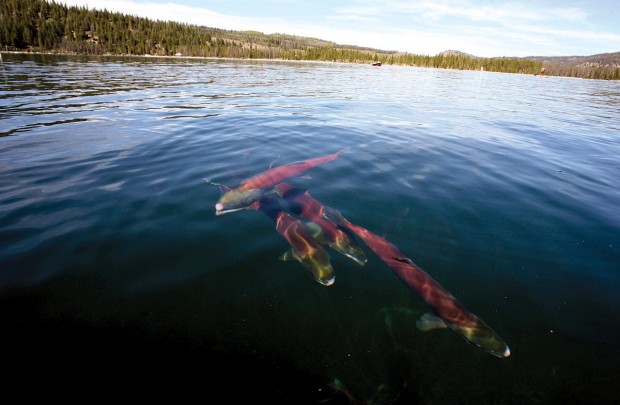forum
library
tutorial
contact

Tribal Summer Chinook, Sockeye Gillnet
Fishery Begin This Week; Sales To Public
by Staff
Columbia Basin Bulletin, June 19, 2014
|
the film forum library tutorial contact |

|
Tribal Summer Chinook, Sockeye Gillnet
by Staff
|
 Treaty Indian gillnet fishing for summer chinook and sockeye salmon began this week in Zone 6 of the Columbia River - Bonneville Dam upriver to McNary Dam - and will continue through at least the next three weeks.
Treaty Indian gillnet fishing for summer chinook and sockeye salmon began this week in Zone 6 of the Columbia River - Bonneville Dam upriver to McNary Dam - and will continue through at least the next three weeks.
The treaty fishery was set at last week's two-state Columbia River Compact meeting, along with several other openings beginning June 16 for summer chinook, sockeye and steelhead as summer fishing hit full swing in all areas of the Columbia River from Tongue Point near Astoria upstream to Priest Rapids Dam and in the Snake River.
Kyle Dittmer of the Columbia River Inter-Tribal Fish Commission said at the Technical Management Team meeting Wednesday, June 17, that treaty fishing would run for three consecutive weeks with each week's fishery lasting about three and half days.
Pool fluctuations greater than 1.5 feet disrupts tribal fishery operations, the SOR says. Problems are increased local currents that sweep debris into nets, entanglement of nets, difficult boat access and nets torn from their anchors.
The Compact forecasts 73,000 adult summer chinook to pass Bonneville Dam, June 16 through July 31. That is less than the 2014 run of 78,300, but 114 percent of the ten-year average return of 64,100 adults. Summer chinook are not listed under the federal Endangered Species Act and are considered a healthy run of fish. All are destined for Priest Rapids Dam.
Some 42,000 of these fish are available for harvest. According to rules set by the U.S. v Oregon Management Agreement and the Upper Columbia River Management Agreement, the available harvest is to be split equally between treaty and non-Indian fisheries.
Non-Indian fishing includes 5,000 fish caught offshore, so treaty fishers are allowed 21,800 fish and non-Indian fishers are allowed 16,000 fish in the river.
The Compact is also forecasting a strong sockeye run of 394,000 fish. The allowable treaty Indian fishery harvest (both gillnetting and platform fishing) is 27,580 sockeye salmon.
Most of the returning sockeye are heading to the Okanagan River in north-central Washington. The recent surge in the sockeye returns is due to a number of sockeye enhancement programs currently underway by the Okanagan Nation Alliance, a group of First Nations tribes in British Columbia, according to CRITFC.
The Compact estimates the catch for these three openings will be 11,200 summer chinook and 8,900 sockeye.
A significant portion of the salmon will be available to the general public. The sale of sockeye and summer chinook should continue throughout the summer season, peaking over the next two to three weeks, according to CRITFC.
Sales of the fish will be at various locations along the Columbia River, at farmer's markets and common direct-to-public sales locations including: Marine Park in Cascade Locks, Celilo, North Bonneville (one mile east of Bonneville Dam), and Columbia Point in the Tri-Cities area.
The tribal fishery is protected under 1855 treaties with the federal government, where the Yakama, Warm Springs, Umatilla, and Nez Perce tribes reserved the right to fish at all usual and accustomed fishing places in the Columbia River Basin -- a treaty right that reserves ceremonial, subsistence, and commercial uses.
A summer chinook non-Indian commercial fishery was also approved by the Compact last week for 9 pm, Wednesday June 17 through 5 am Thursday, June 18 (8 hours).
Summer recreational fishing opened June 16 through July 6 from the Astoria-Megler Bridge in Astoria upstream to Bonneville Dam and June 16 through July 31 from Bonneville Dam upstream to Priest Rapids Dam for both adipose fin-clipped chinook and sockeye salmon. The daily bag limit includes two hatchery adult salmon. Sockeye can be retained as part of the adult daily bag limit.
Both treaty and non-treaty fishery catches will be adjusted throughout the season as the run size is updated.
Related Sites:
Ocean conditions drove recent Columbia River sockeye booms by Northwest Fisheries Science Center
Related Pages:
Let's Start Talking About Delisting Sockeye by Scott Levy, Idaho Statesman, 11/19/14
Count the Fish, 1977-2010 Salmon Recovery Efforts, by Government Accountability Office
learn more on topics covered in the film
see the video
read the script
learn the songs
discussion forum
